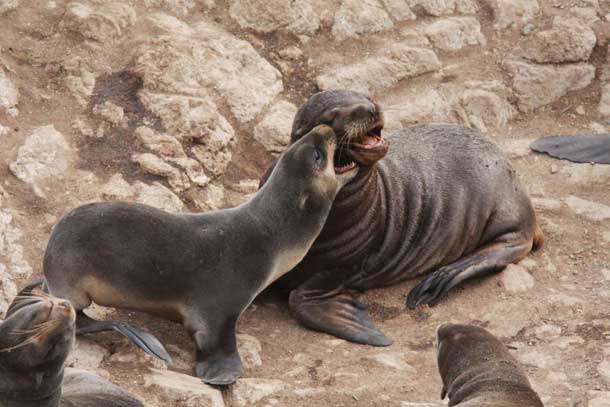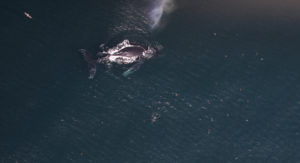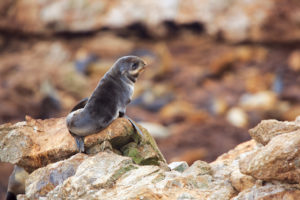Such a loveable face could melt even the stoniest heart. The docile expression and liquid eyes of the northern fur seal make this creature the perfect poster child for animal welfare groups.
Don’t be fooled.
Jim Tietz, a PRBO Conservation Science biologist who helps monitor the colony on the Farallon Islands National Wildlife Refuge, says these marine mammals are playful and curious–even aggressive. And they’re making a comeback, at least on islands off the California coast.
“It was a good season for pups,” says Tietz. “We counted over 180 pups during one survey.”
The rocky Farallones, 28 miles west of the Golden Gate, serve as a refuge for thousands of seabirds and five species of pinnipeds: elephant seals, harbor seals, California and Steller sea lions, and the northern fur seal. At one time, fur seals may have dominated the islands, but relentless hunting in the early 19th century exterminated most of the colony and sent the rest fleeing. Biologists have spotted individual seals over the years, but it wasn’t until 1996 that the first fur seal pup was born on Southeast Farallon Island. Today hundreds of fur seals breed here, and the colony is growing exponentially. The high count for 2011 was 476 individuals, a 69 percent increase from the year before.
The burgeoning colony has settled on Indian Head Beach, a rocky area on West End, just across a narrow channel from Southeast Farallon Island. When Tietz first started monitoring the population in 2006, this area was dominated by California sea lions–and to a lesser extent, elephant seals.
“The population has shifted dramatically,” says Tietz. “The sea lions have been displaced to Southeast Farallon Island, despite the fact that they’re bigger than the fur seals.”
Fur seals are far more aggressive than the shyer sea lions. Even a fur seal pup moving through a group of sea lions will bare its teeth.
“When we go to count we have to be careful not to spook the sea lions because they’re scared of humans,” says Tietz. “With fur seals it’s very different. If one’s blocking the path, we have to use a pole to push them back.”
Fur seals are also extremely playful. Pups, immature “adolescents,” and even adults play in the intertidal area, chasing each other and engaging in mock battles.
- A fur seal (left) and Stellar sea lion pup playing on the Farallon Islands. Photo by Jim Tietz, courtesy PRBO Conservation Science.
“Sometimes you see them doing endless circles,” says Tietz. “Or they’ll have something in their mouth, and they’ll be playing with that.” Tietz has even witnessed a prolonged play date between a fur seal and Steller sea lion pup.
The northern fur seal is an “eared seal,” in the same family as California and Steller sea lions. These seals have external ears, long front flippers, and a pelvis that rotates forward, making them much more nimble on land than “earless seals” like harbor and elephant seals. All members of this family show extreme sexual dimorphism–males are up to four times larger than females, with thick necks and “linebacker” shoulders.
Unlike other seals and sea lions, the northern fur seal relies on dense fur rather than blubber for insulation.
“They’re very skinny,” says Tietz. “Their waist is narrow, which is opposite of harbor and elephant seals.”
Their fur is incredibly dense–up to 300,000 hairs can crowd an area the size of a postage stamp. Thanks to this insulation, fur seals spend most of their lives at sea aside from the few months spent on land during the breeding season.
Their dense fur also got them into trouble.
In 1807 American trading companies began harvesting fur seals on the Farallones. Between 100,000 and 150,000 seals were killed in a five-year period. Later, Russians and the Aleuts they hired as hunters got into the act.
This destructive pattern occurred throughout the fur seal’s range. Over half the global population breeds on Alaska’s Pribilof Islands, in the eastern part of the Bering Sea. Hunting devastated the population, which declined from 2.5 million to 215,000 by the early 20th century. The International North Pacific Fur Seal Treaty of 1911 between the United States, Russia, Canada and Japan put a stop to the plundering. The population rebounded, but has recently begun to decline again.
The International Union for Conservation of Nature (IUCN) lists the northern fur seal as “vulnerable,” and the Pribilof colonies are listed as “depleted” under the Marine Mammal Protection Act. Seals may only be taken by subsistence hunters. Yet despite protections, the Pribilof colonies are not thriving; the pupping rate has been declining steadily. Today the fur seal faces different, more complicated threats than hunters: pollution, disturbance, climate change, deaths due to entanglements in gill nets or marine debris, and over-fishing that depresses prey populations. In particular, the pollack fishery may be affecting the availability of one of the seal’s preferred foods.
Unlike a species like the elephant seal, which nurses its pups constantly, fur seal mothers take foraging trips and are often gone for a week at a time.
“If prey is scarce, mothers may have to spend even more time away from their pups,” says Tietz. Sometimes mothers even abandon them.
If there’s a silver lining, it’s that colonies have reformed, both in the Aleutians and off the California coast. The southernmost colonies are thriving and growing. Fur seals began breeding on San Miguel Island, one of the Channel Islands, in the 1960s.
“They started to see flipper tags on seals at San Miguel,” says Tietz. “And they were all from the Pribilof or Commander Islands (in Russia’s Bering Sea).” Today the San Miguel colony, which may have peaked, numbers around 10,000 animals.
Almost all of the Farallon Island fur seals, on the other hand, hail from San Miguel. These pioneers first hauled out on Southeast Farallon Island, then moved to the colony’s current location on Indian Head Beach, which Tietz calls a “sensitive area.”
“California sea lions and several species of seabirds also breed there,” says Tietz. “The pupping season (for fur seals) coincides with the nesting season of seabirds.”
To avoid disturbing them, Tietz and the other biologists limit the amount of direct interaction with the seals by monitoring the colony from Lighthouse Hill, a high point on Southeast Farallon Island. The disadvantage is that part of the colony is obscured by Maintop Hill, which means the count of 180 pups for the 2011 season is likely a conservative number. Tietz hopes to start using aerial photographs of the colonies to obtain more accurate counts without causing additional disturbance.
Though they avoid the area during the seabird nesting season, the biologists do trek to West End several times a year for a closer peek at the fur seal colony. This time of year, the pups are mostly weaned and are starting to leave their island refuge. Many of them won’t see land again for a year or more.

.jpg)




